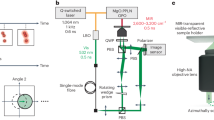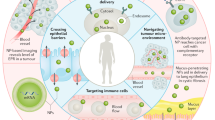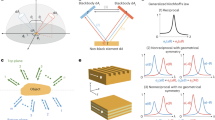Abstract
In biomedical imaging, nanoparticles combined with radionuclides that generate Cerenkov luminescence are used in diagnostic imaging, photon-induced therapies and as activatable probes. In these applications, the nanoparticle is often viewed as a carrier inert to ionizing radiation from the radionuclide. However, certain phenomena such as enhanced nanoparticle luminescence and generation of reactive oxygen species cannot be completely explained by Cerenkov luminescence interactions with nanoparticles. Herein, we report methods to examine the mechanisms of nanoparticle excitation by radionuclides, including interactions with Cerenkov luminescence, β particles and γ radiation. We demonstrate that β-scintillation contributes appreciably to excitation and reactivity in certain nanoparticle systems, and that excitation by radionuclides of nanoparticles composed of large atomic number atoms generates X-rays, enabling multiplexed imaging through single photon emission computed tomography. These findings demonstrate practical optical imaging and therapy using radionuclides with emission energies below the Cerenkov threshold, thereby expanding the list of applicable radionuclides.
This is a preview of subscription content, access via your institution
Access options
Access Nature and 54 other Nature Portfolio journals
Get Nature+, our best-value online-access subscription
$29.99 / 30 days
cancel any time
Subscribe to this journal
Receive 12 print issues and online access
$259.00 per year
only $21.58 per issue
Buy this article
- Purchase on Springer Link
- Instant access to full article PDF
Prices may be subject to local taxes which are calculated during checkout






Similar content being viewed by others
References
Pratt, E. C., Shaffer, T. M. & Grimm, J. Nanoparticles and radiotracers: advances toward radionanomedicine. Wiley Interdiscip. Rev. Nanomed. Nanobiotechnol. 8, 872–890 (2016).
Benezra, M. et al. Ultrasmall integrin-targeted silica nanoparticles modulate signaling events and cellular processes in a concentration-dependent manner. Small 11, 1721–1732 (2015).
Kotagiri, N., Sudlow, G. P., Akers, W. J. & Achilefu, S. Breaking the depth dependency of phototherapy with Cerenkov radiation and low-radiance-responsive nanophotosensitizers. Nat. Nanotech. 10, 370–379 (2015).
Shaffer, T. M. Silica nanoparticles as substrates for chelator-free labeling of oxophilic radioisotopes. Nano Lett 15, 864–868 (2015).
Shaffer, T. M. Stable radiolabeling of sulfur-functionalized silica nanoparticles with copper-64. Nano Lett 16, 5601–5604 (2016).
Hoogendam, J. P. et al. 99mTc-nanocolloid SPECT/MRI fusion for the selective assessment of nonenlarged sentinel lymph nodes in patients with early-stage cervical cancer. J. Nucl. Med. 57, 551–556 (2016).
Phillips, E. et al. Clinical translation of an ultrasmall inorganic optical-PET imaging nanoparticle probe. Sci. Transl. Med. 6, 260ra149 (2014).
Thorek, D. L. et al. Non-invasive mapping of deep-tissue lymph nodes in live animals using a multimodal PET/MRI nanoparticle. Nat. Commun. 5, 3097 (2014).
Chen, F. et al. In vivo integrity and biological fate of chelator-free zirconium-89-labeled mesoporous silica nanoparticles. ACS Nano 9, 7950–7959 (2015).
Perez-Medina, C. et al. A modular labeling strategy for in vivo PET and near-infrared fluorescence imaging of nanoparticle tumor targeting. J. Nucl. Med. 55, 1706–1711 (2014).
Sun, X. et al. Self-illuminating 64Cu-doped CdSe/ZnS nanocrystals for in vivo tumor imaging. J. Am. Chem. Soc. 136, 1706–1709 (2014).
Goel, S., England, C. G., Chen, F. & Cai, W. Positron emission tomography and nanotechnology: A dynamic duo for cancer theranostics. Adv. Drug. Deliv. Rev. 113, 157–176 (2016).
Shaffer, T. M., Pratt, E. C. & Grimm, J. Utilizing the power of Cerenkov light with nanotechnology. Nat. Nanotech. 12, 106–117 (2017).
Czupryna, J. et al. Cerenkov-specific contrast agents for detection of pH in vivo. J. Nucl. Med. 56, 483–488 (2015).
Robertson, R. et al. Optical imaging of Cerenkov light generation from positron-emitting radiotracers. Phys. Med. Biol. 54, N355–N365 (2009).
Thorek, D. L., Riedl, C. C. & Grimm, J. Clinical Cerenkov luminescence imaging of 18F-FDG. J. Nucl. Med. 55, 95–98 (2014).
Spinelli, A. E. et al. First human Cerenkography. J. Biomed. Opt. 18, 20502 (2013).
Spinelli, A. et al. Cerenkov and radioluminescence imaging of brain tumor specimens during neurosurgery. J. Biomed. Opt. 21, 50502 (2016).
Hu, H. et al. Feasibility study of novel endoscopic Cerenkov luminescence imaging system in detecting and quantifying gastrointestinal disease: first human results. Eur. Radiol. 25, 1814–1822 (2015).
Grootendorst, M. R., Cariati, M., Kothari, A., Tuch, D. S. & Purushotham, A. Cerenkov luminescence imaging (CLI) for image-guided cancer surgery. Clin. Transl. Imaging 4, 353–366 (2016).
Grootendorst, M. R. et al. Intraoperative assessment of tumor resection margins in breast-conserving surgery using 18F-FDG Cerenkov luminescence imaging: a first-in-human feasibility study. J. Nucl. Med. 58, 891–898 (2017).
Thorek, D. L., Ogirala, A., Beattie, B. J. & Grimm, J. Quantitative imaging of disease signatures through radioactive decay signal conversion. Nat. Med. 19, 1345–1350 (2013).
Ouyang, Z., Liu, B., Yasmin-Karim, S., Sajo, E. & Ngwa, W. Nanoparticle-aided external beam radiotherapy leveraging the Cerenkov effect. Phys. Med. 32, 944–947 (2016).
Glaser, A. K., Zhang, R., Andreozzi, J. M., Gladstone, D. J. & Pogue, B. W. Cherenkov radiation fluence estimates in tissue for molecular imaging and therapy applications. Phys. Med. Biol. 60, 6701–6718 (2015).
Shaffer, T. M., Drain, C. M. & Grimm, J. Optical imaging of ionizing radiation from clinical sources. J. Nucl. Med. 57, 1661–1666 (2016).
Letant, S. E. & Wang, T. F. Semiconductor quantum dot scintillation under gamma-ray irradiation. Nano Lett. 6, 2877–2880 (2006).
Hu, Z. et al. In vivo nanoparticle-mediated radiopharmaceutical-excited fluorescence molecular imaging. Nat. Commun. 6, 7560 (2015).
Cao, X. et al. Intensity enhanced Cerenkov luminescence imaging using terbium-doped Gd2O2S microparticles. ACS Appl. Mater. Interfaces 7, 11775–11782 (2015).
Ma, X. et al. Enhancement of Cerenkov luminescence imaging by dual excitation of Er3+,Yb3+-doped rare-earth microparticles. PLoS ONE 8, e77926 (2013).
Karnkaew, A., Chen, F., Zhan, Y. H., Majewski, R. L. & Cai, W. B. Scintillating nanoparticles as energy mediators for enhanced photodynamic therapy. ACS Nano 10, 3918–3935 (2016).
Sun, C. et al. Synthesis and radioluminescence of PEGylated Eu3+-doped nanophosphors as bioimaging probes. Adv. Mater. 23, H195–H199 (2011).
Mitchell, G. S., Gill, R. K., Boucher, D. L., Li, C. & Cherry, S. R. In vivo Cerenkov luminescence imaging: a new tool for molecular imaging. Philos. Trans. R. Soc. A 369, 4605–4619 (2011).
Sitharamaro, D. N. & Duncan, J. F. Molecular excitation of water by gamma-irradiation. J. Phys. Chem. 67, 2126–212 (1963).
McParland, B. J. Charged Particle Interactions with Matter (Springer-Verlag, Godalming, 2010).
Carnall, W. T., Fields, P. R. & Rajnak, K. Electronic energy levels of trivalent lanthanide aquo ions. 4. Eu3+. J. Chem. Phys. 49, 4450–445 (1968).
Sudheendra, L. et al. NaGdF4:Eu3+ nanoparticles for enhanced X-ray excited optical imaging. Chem. Mat. 26, 1881–1888 (2014).
Villa, I. et al. Size-dependent luminescence in HfO2 nanocrystals: towards White Emission from Intrinsic Surface Defects. Chem. Mater. 28, 3245–3253 (2016).
Zorenko, Y. et al. Luminescence properties of Y3Al5O12:Ce nanoceramics. J. Lumin. 131, 17–21 (2011).
Geraki, K., Farquharson, M. J. & Bradley, D. A. X-ray fluorescence and energy dispersive X-ray diffraction for the quantification of elemental concentrations in breast tissue. Phys. Med. Biol. 49, 99–110 (2004).
Margui, E., Queralt, I. & Hidalgo, M. Application of X-ray fluorescence spectrometry to determination and quantitation of metals in vegetal material. Trends Anal. Chem. 28, 362–372 (2009).
Scofield, J. H. Radiative decay rates of vacancies in the K and L shells. Phys. Rev. 179, 9–16 (1969).
Wojtowicz, A. J. Rare-earth-activated wide bandgap materials for scintillators. Nucl. Instrum. Methods Phys. Res. Sect. A 486, 201–207 (2002).
Liu, F., Cui, Q., He, J. & Fei, D. Preparation, characterization and ionizing radiation protection properties of electrospun nanofibrous mats embedded with erbium oxide (Er2O3) nanoparticles. J. Nano Res. 27, 121–127 (2014).
Tang, R., Habimana-Griffin, L. M., Lane, D. D., Egbulefu, C. & Achilefu, S. Nanophotosensitive drugs for light-based cancer therapy: what does the future hold? Nanomedicine 12, 1101–1105 (2017).
Nakamura, Y. et al. Cerenkov radiation-induced photoimmunotherapy with 18F-FDG. J. Nucl. Med. 58, 1395–1400 (2017).
Hartl, B. A., Hirschberg, H., Marcu, L. & Cherry, S. R. Activating photodynamic therapy in vitro with Cerenkov radiation generated from yttrium-90. J. Environ. Pathol. Toxicol. Oncol. 35, 185–192 (2016).
Pritychenko, B., Běták, E., Kellett, M. A., Singh, B. & Totans, J. The Nuclear Science References (NSR) database and web retrieval system. Nucl. Instrum. Methods Phys. Res. Sect. A 640, 213–218 (2011).
Wall, M. A. et al. Chelator-free radiolabeling of SERRS nanoparticles for whole-body PET and intraoperative Raman imaging. Theranostics 7, 3068–3077 (2017).
Deslattes, R. D. et al. X-ray transition energies: new approach to a comprehensive evaluation. Rev. Mod. Phys. 75, 35–99 (2003).
Acknowledgements
We thank BTG Interventional Medicine for the supply of Theraspheres required to conduct the in vivo imaging. The Australian Nuclear Science and Technology Organization (ANSTO) is acknowledged for their generous provision of a research-grade gallium-68 generator and purification system along with the MSKCC nuclear pharmacy for 18FDG. We thank the MSKCC Radiochemistry and Molecular Imaging Probes Core for technical assistance with the Ge detector, P. Zanzonico and V. Longo of the Small Animal Imaging Core for their direction and assistance on the NanoSPECT/CT and medical physics discussions. This work was supported by the following grants: National Institutes of Health (NIH) R01EB014944 and R01CA183953 (to J.G.), T32 CA196585 (to T.M.S.), and National Science Foundation Integrative Graduate Education and Research Traineeship grant (DGS 0965983, at Hunter College). Technical services provided by the MSKCC Small-Animal Imaging Core Facility, supported in part by NIH Centre Grant number P30 CA08748, are gratefully acknowledged. NIH Shared Instrumentation Grant number 1 S10 RR028889-01, which provided funding support for the purchase of the NanoSPECT/CT Plus, and a Shared Resources Grant from the MSKCC Metastasis Research Centre, which provided funding support for the purchase of the IVIS Spectrum, are also gratefully acknowledged.
Author information
Authors and Affiliations
Contributions
E.C.P., T.M.S., and Q.Z. devised and carried out the experiments. E.C.P. and T.M.S. wrote the manuscript. J.G. and C.M.D. supervised the project and edited the manuscript. All authors contributed discussions on the project.
Corresponding author
Ethics declarations
Competing interests
E.C.P., T.M.S. and J.G. have filed an international patent application regarding the content of the manuscript (PCT/US2016/018502).
Additional information
Publisher’s note: Springer Nature remains neutral with regard to jurisdictional claims in published maps and institutional affiliations.
Supplementary information
Supplementary Information
Supplementary Discussion, Supplementary Figures 1–23, Supplementary References.
Rights and permissions
About this article
Cite this article
Pratt, E.C., Shaffer, T.M., Zhang, Q. et al. Nanoparticles as multimodal photon transducers of ionizing radiation. Nature Nanotech 13, 418–426 (2018). https://doi.org/10.1038/s41565-018-0086-2
Received:
Accepted:
Published:
Issue Date:
DOI: https://doi.org/10.1038/s41565-018-0086-2
This article is cited by
-
Multimodal radiolabeled gold nanoparticle molecular probes: synthesis, imaging, and applications
Journal of Radioanalytical and Nuclear Chemistry (2023)
-
Enhancing light yield of Tb3+-doped fluoride nanoscintillator with restricted positive hysteresis for low-dose high-resolution X-ray imaging
Nano Research (2023)
-
Prospective testing of clinical Cerenkov luminescence imaging against standard-of-care nuclear imaging for tumour location
Nature Biomedical Engineering (2022)
-
Activation of nano-photosensitizers by Y-90 microspheres to enhance oxidative stress and cell death in hepatocellular carcinoma
Scientific Reports (2022)
-
Role of nanoparticles in transarterial radioembolization with glass microspheres
Annals of Nuclear Medicine (2022)



